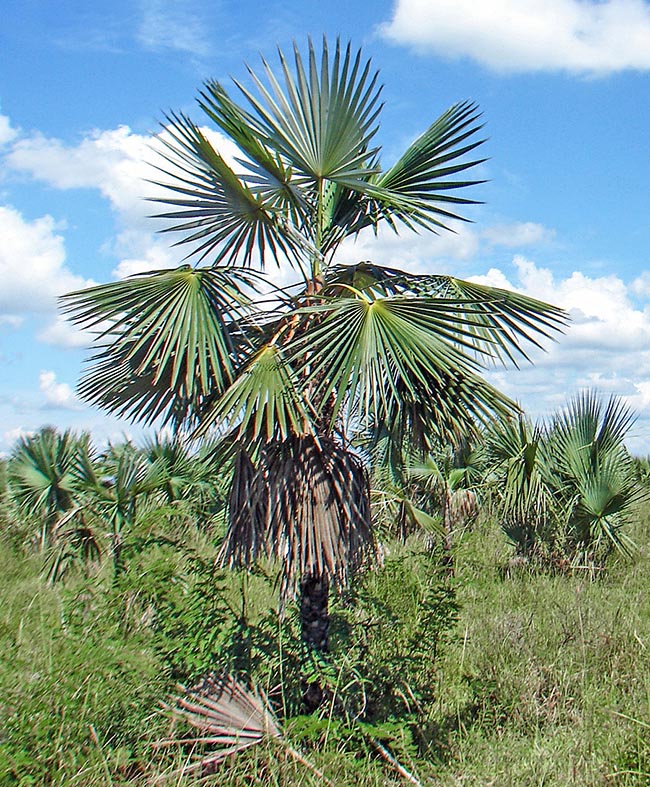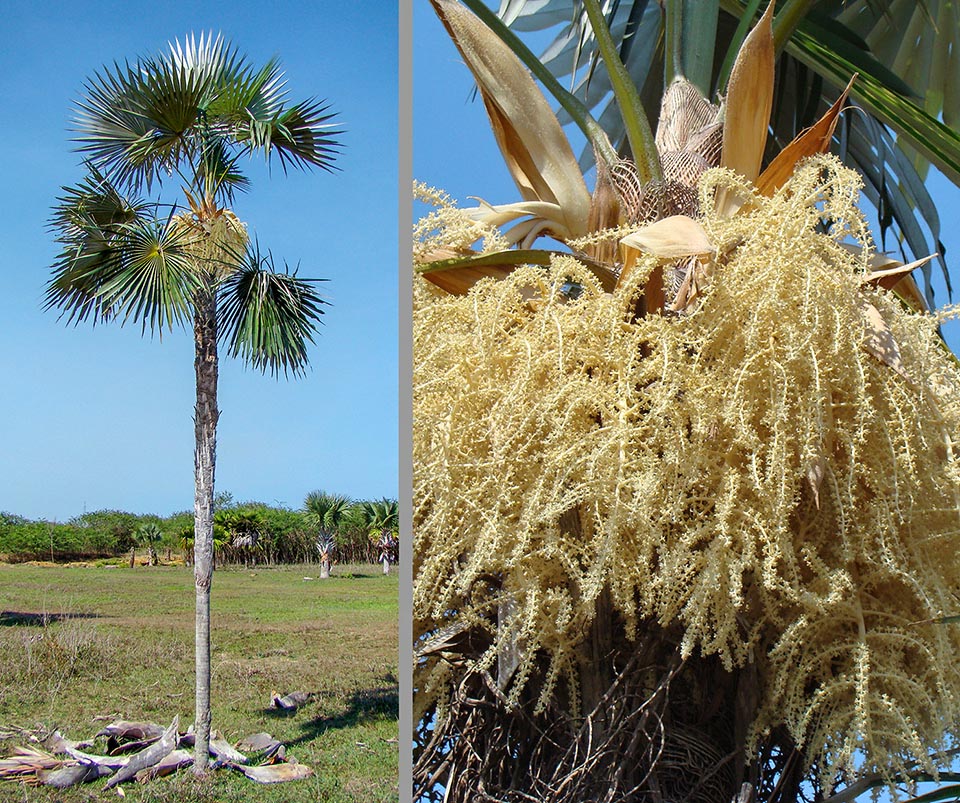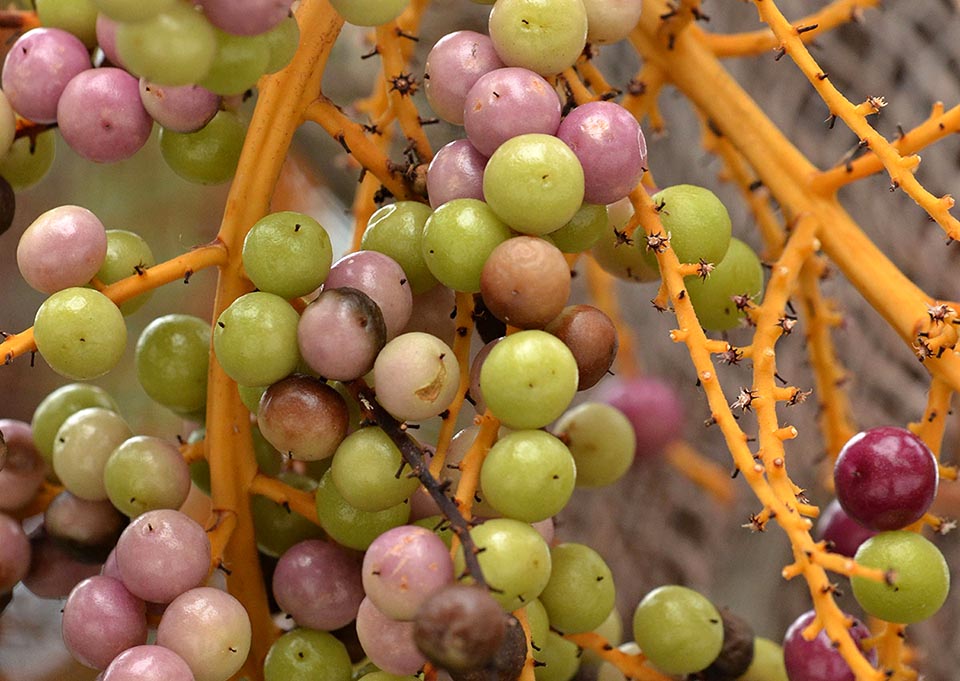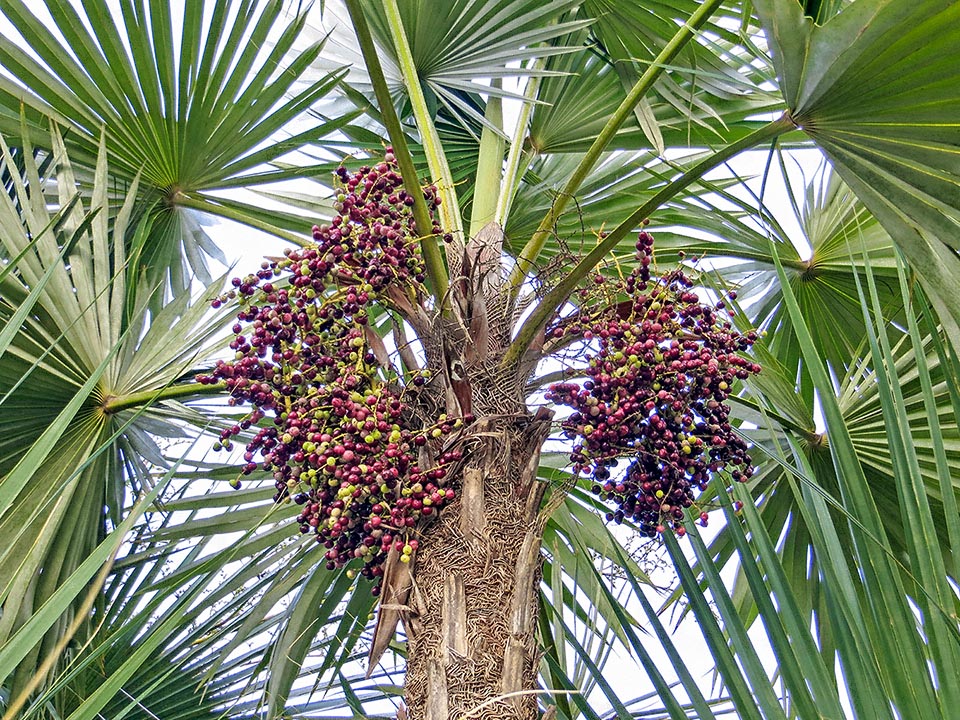Family : Arecaceae

Text © Alessandro Marini

English translation by Mario Beltramini

Coccothrinax miraguama is an endemic Cuban species present in various habitats © Duanny Suárez
Coccothrinax miraguama (Kunth) Becc. is endemic to the island of Cuba where it is the most diffused species of the genus Coccothrinax.
It grows in quite different environments of the island: hills, savannahs, open woods and coastal sites and the populations differ in some characteristics that are ascribed to three subspecies officially recognized.
The generic name Coccothrinax comes from the combination of the Greek term “κόκκος” (coccos) = berry and of the name of the genus Thrinax to which these plants resemble; the Latin specific name miraguama refers to the common local name of the plant, “miraguamo”.
Common names: miraguano, yuraguana (Spanish), miraguama palm (English).
The Coccothrinax miraguama is a monoecious unarmed species with single stem, 4 to 10 m tall, cylindrical, with a diametre of 8-10 cm.
The foliar bases wrap the stem where they remain attached for a long time, then fall leaving the stem smooth of grey colour. They are up to 40 cm long, formed by 2 or 3 layers of rigid woody fibres, strictly crossed and interlaced, 1,5-2 mm broad. The most recent ones are covered with a white tomentum.
The unarmed petioles are 70-80 cm long and 1,5-2 cm broad, ampler at the base. The intersection point between petiole and leaf is a rigid tang with raised edges that may vary from round to triangular in the various subspecies.
The foliar lamina is palmate, urbicular, of glossy green colour on the upper pagina and whitish grey on the lower one. It is etched and presents in rigid foliar segments, united for about half of the length of the leaf, in number of 40-50, with the central segment longer, 40 to 70 cm depending on the subspecies, 5 to 6 cm broad in the widest point close to the tip, where it sharply narrows and diminishes forming a bifid acuminate triangular apex.
The inflorescences, shorter than the petioles, are interfoliar, 70 cm long and present 1 to 4 primary spaced ramifications and decreasing in length towards the apex. The ramifications are up to 35 cm long. The lowest rachillae are 15-20 cm long and 4 mm broad. The flowers are hermaphrodite, on a 1 to 6 mm long pedicel of cream colour, fragrant, with 8-12 stamens. Globose, rarely oval, fruits, of 7-12 mm of diametre, blackish colour when ripe, containing only one seed of 5-8 mm of diametre.

Total and detail of a Coccothrinax miraguama subsp. miraguama in flower. To note the smooth stem below © Duanny Suárez
Coccothrinax miraguama is distinguished in three subspecies, though various botanists and experts have recently suggested to ascribe them to one only species.
The most widely diffused in the Cuban territory is the Coccothrinax miraguama subsp. miraguama that has the highest stem, almost double that of the other two subspecies. Coccothrinax miraguama subsp. havanensis is the only one growing close to the coasts and differs because having a thinner foliar lamina with the segments tending to hang down. Coccothrinax miraguama subsp. roseocarpa distinguishes for the pink colour of the ripe fruits and for the foliar lamina very thick and coriaceous compared to the others.
It reproduces by seed, previously kept in water for three days, in sandy loam maintained huùid at the temperature of 26-28 °C, with germination times starting from 2-3 months or more.

Ripening fruits. Globose, rarely oval, blackish when ripe, they measure 7-12 mm of diametre and contain only one seed © Cerlin Ng
Coccothrinax miraguama is considered as the most beautiful species of the genus Coccothrinax thanks to its circular corona of very rigid and silvery oval leaves and the drawing of the fibres strictly interlaced on the stem.
Coccothrinax miraguama subsp. miraguama is fairly diffused in cultivation and can be admired in public botanical gardens and in private collections all over the tropical and subtropical belt. The other two subspecies are rather rare.
The exposition must be in full sun or at most in half-shade. It is not particularly demanding about the soil, even if poor, that, however, must be perfectly draining, also alkaline. The adult specimens can stand periods of drought, also in the zones with warm and dry summers it is preferable to water from time to time. It is a species born for a tropical or subtropical climate, even if the adult specimens can stand light frosts up to -1 °C.

Coccothrinax miraguama subsp. miraguama full of fruits. Foliar bases wrap the stem with 2 or 3 layers of rigid woody fibres, strictly crossed and interlaced © Duanny Suárez
Compared to the other species of the genus Coccothrinax, it is relatively fast in growing. The state of conservation is quite different depending on the subspecies. The International Union for Conservation of Nature (IUCN) considers the Coccothrinax miraguama subsp. miraguama “at least concern” because it has the greatest population of the genus Coccothrinax on Cuban territory, whilst Coccothrinax miraguama subsp. roseocarpa is considered as “Near Threatened” being present only in the province of Matanzas, even if in a fair number of specimens. Conversely, Coccothrinax miraguama subsp. havanensis is classified “Critically Endangered”, due to the very reduced and fragmented habitat.
The local population utilizes the fibres of the foliar bases for realizing brooms and brushes.
Synonyms: Thrinax stellata Lodd. ex Mart. 1853; Thrinax acuminata Griseb. & H.Wendl. ex Sarg. 1899; Thrinax yuraguana A.Rich 1939; Thrinax miraguama (Kunth) Mart. 1853; Copernicia miraguama (Kunth) Kunth 1841; Corypha miraguama Kunth 1816; Coccothrinax acuminata Griseb. & H.Wendl. ex Sarg. 1901.
